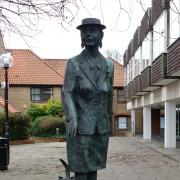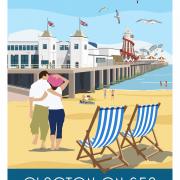Queen Elizabeth I’s surgeon, experimental scientist and creator of the science of magnetism, Stephen Roberts delves into the life of this forgotten Colchester genius
Physician, philosopher and physicist William Gilbert was an alliterative brainbox best remembered as the author of De Magnete (1600) and for coining the word ‘electricity’. Without him we might have another word for the leccie bill. He created the science of magnetism, was the first scientist adopting a thoroughly experimental approach, an early supporter of Copernicus in believing the Earth to be driven around the Sun and an eminent physician and doc.
Born in Colchester on May 24, 1544, Gilbert did well, becoming surgeon to Queen Elizabeth I and the most eminent scientist of her reign who’s justifiably regarded as the ‘father of electrical science’. He was born into a prosperous family, the son of Jerome Gilberd, a lawyer, judge and borough recorder, and Elizabeth Coggeshall. The eldest of four, his birthplace was Tymperleys, a house dating to the 1490s, but expanded significantly in William’s time. William’s mother died whilst he was young but he acquired seven half-siblings via a stepmother, Jane Wingfield. Bright spark Gilbert was educated at Colchester Grammar and from 1558, aged 14, at St John’s Cambridge where he’d be elected a fellow in 1561. He’d obtain his M.D. (Doctor of Medicine) in 1569.

This was an exciting time to be a surgeon. In 1540, towards the end of the reign of Elizabeth’s father, Henry VIII, the Fellowship of Surgeons merged with the Company of Barbers to form the Company of Barber-Surgeons. And so, the barber-surgeon was born. It may seem bizarre today, but it was possible to have a tooth pulled, a leg sawn off and your hair cut all by the same person, although not necessarily on the same occasion – ‘I’ve got awful toothache, my left leg’s giving me gyp, and while you’re at it could you give my beard a trim?’ The separation of surgeons and barbers did not take place until 1745. I have no idea whether William did the odd short back and sides, but I like to think he did.
Back to the plot, and come 1573 Gilbert had settled in London where he practiced, being also elected a Fellow of the Royal College of Physicians in the same year and becoming this august body’s President in 1600. He’d also had the opportunity to travel extensively on the continent. He must have been very experienced by the time he became physician to Queen Elizabeth I in 1601, a position he’d hold until her death in March 1603. It was renewed for the new monarch, James I/VI, the prestigious calling only being terminated by Gilbert’s own demise in November 1603. Being Liz’s doc was not all roses. She was a tough task mistress as she had an innate distrust of medics.

Gilbert’s De Magnete, or On the magnet (1600), was the first published work of experimental physics. In its Latin pages, he established the magnetic nature of the Earth, while he speculated that terrestrial magnetism and electricity were two ‘allied emanations of a single force’ although he also distinguished between true magnetism and static (a.k.a. the amber effect). He was ahead of his time and sensing something called ‘electromagnetism,’ which would be a Victorian discovery. Gilbert described the many experiments he’d conducted with his model Earth, concluding that our planet acts as a bar magnet, which was why compasses pointed north, and why we have North and South Poles. He correctly deduced that a magnet’s polarity behaved in the same way as the Earth’s and explained the Earth’s ability to spin or rotate on an axis. Gilbert was also the first scientists to research the properties of the lodestone (magnetic iron ore) and argued (correctly) that the Earth had an iron core and that magnets could be cut to form smaller magnets.
An electrical pioneer, it was Gilbert who first coined the terms ‘electricity’, ‘electric force’, ‘electric attraction’ and ‘magnetic pole’ and there’s a unit of magnetomotive power named after him, the ‘gilbert’. That word electricity was first used in its English form in 1646, long after Gilbert’s death, but it came directly from his New Latin ‘electricus’ of 1600, which translates ‘like amber’. He also postulated that amber was not the only substance attracting light objects when rubbed like a genie’s lamp. He invented the first electrical measuring device, an electroscope.

Gilbert was also into astronomy and was one of the earliest to argue that the Earth revolved rather than the stars, although he was not the very first as Copernicus had spoken openly about such an arrangement about half a century before. Gilbert was the first though to attempt a mapping of the Moon’s markings, which he took on in the 1590s. He preferred experiment over conjecture – a true scientist. The trouble was, being a scientist in the 16th century didn’t impress everyone; the Roman Catholic Church’s Inquisition had him on its reactionary reproving radar. To be fair to Gilbert, it was a 17-year research project on his part at a time when received mumbo jumbo included the ‘fact’ that garlic interfered with the workings of a compass. The Inquisition may have disapproved, but Gilbert was right. He was the first to explain the workings of a magnetic compass.
William Gilbert died in London on November 30, 1603, aged 59. It’s believed that he died from the bubonic plague that swept the city. He lies buried in his home town of Colchester at Holy Trinity. A marble wall monument to him is inside the church, now deconsecrated, which acts as a market and café called the GO4. Curiously, Gilbert’s home, Tymperleys, is also now a café. Our knowledge of William Gilbert’s interesting life is sketchy as his personal papers were lost in the Great Fire of London in 1666. What we do know is that William Gilbert is a forgotten genius who deserves to be better known as he influenced the likes of Kepler, Hooke, Newton, Galileo and even Christopher Wren. I hope I’ve brought this Colchester boy back into the light for you.
CHRONOLOGY
1544 – Posited birth date of William Gilbert in Colchester (May 24).
1558 – Gilbert enters St John’s, Cambridge aged 14, becoming bachelor, master and doctor.
1569 – William leaves Cambridge as an M.D. (Doctor of Medicine).
1573 – Begins practicing as an increasingly eminent physician in London.
1600 – Publication of Gilbert’s magnum opus De Magnete.
1601 – Appointed physician to Queen Elizabeth I.
1603 – Death of William Gilbert (November 30) aged 59.
1651 – Posthumous publication of De Mundo, Gilbert’s other great work.




























